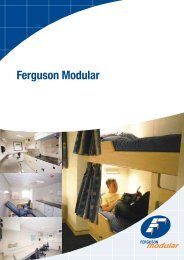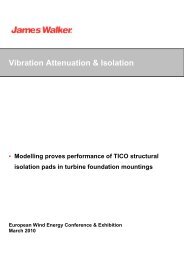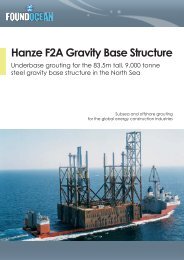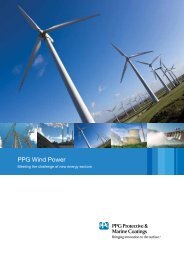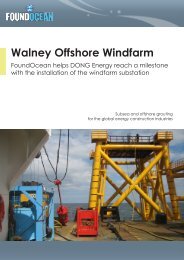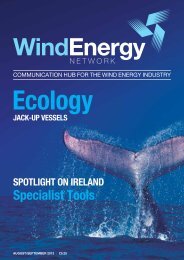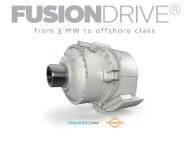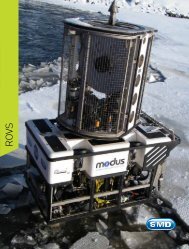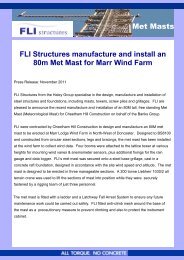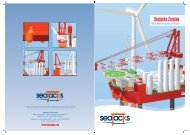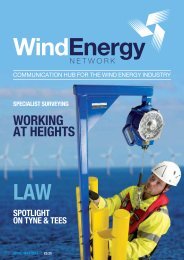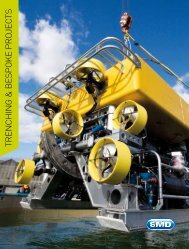JUNE/JULY 2013 | £5.25 - Wind Energy Network
JUNE/JULY 2013 | £5.25 - Wind Energy Network
JUNE/JULY 2013 | £5.25 - Wind Energy Network
You also want an ePaper? Increase the reach of your titles
YUMPU automatically turns print PDFs into web optimized ePapers that Google loves.
legal eagleslegal eaglesBuilding on firmfoundationsOffshore construction projects,whether for renewable energydevelopment or otherwise, arecomplex projects requiring thecontractual arrangement and risksharing associated with the designand construction of the project,together with operation followingconstruction, to be carefullyconsidered.Recent case studyThe need for certainty in suchcontracts was highlighted in the recentcase of MT Hoggard A/S v E.ONClimate Renewables UK; Robin RiggEast Limited (1); E.ON Climate andRenewables UK Robin Rigg WestLimited (2).Major undertakingAs the Court said in its judgmentthe construction of offshore windfarms requires the use of substantialcontractors plant and equipment andis a major undertaking. The claimantin this case (MTH) contracted with thedefendants (E.ON) in December 2006to design, manufacture, deliver, installand commission the foundations for60 wind turbine generators (WTGs)and two substations for the RobinRigg <strong>Wind</strong> Farm in the Solway Firthwith a contract value in excess of€100,000,000.Both parties to the contract (and thelitigation) were major and sophisticatedcommercial concerns.Contract specificsThe foundation contract was the earlycontract, or one of them, dependentupon which there would be follow oncontracts for the placing of the windturbines.Under the contract MTH was to provide ajack up barge, the use of which was to beintegral to the installation of the monopilesand transition pieces that together wouldform the foundations of the WTGs. Thejack up barge selected was not selfpropelling and required ancillary equipmentto assist it in its operations and thereforeother vessels and equipment would berequired at not insignificant costs.After the execution of the contract andwhile the works were in progress thejack up barge proved to be inadequatefor the task which it was meant to carryout. It failed to install the foundationsrequired and the engineer under thecontract issued three variation orderswhich required the substitution of adifferent vessel to do the installation workwhich, under the terms of the contract,was previously to be done by the jack upbarge.Preliminary issues andarrangement changesIn order to deal effectively with the litigationthe parties agreed a number of preliminaryissues which it required the Court todetermine prior to a full hearing.A central feature of the changedarrangements was that whereas originallyMTH had been responsible for hiring thejack up barge and providing it for thecontract at its cost the new vessel washired directly by E.ON which then providedit on a free issue basis to MTH to managethe installation process.The contract between the parties madeprovision for the valuation of variationorders but the parties were unable toagree the financial consequences of thechanges in arrangements, which gave riseto the proceedings and the preliminaryissues. MTH was of the view that whatshould be omitted was a componentof the original contract price included inthe price of the jack up barge makingdue allowance for the fact that it carriedout two of the sixty two foundationinstallations.However, E.ON’s position was thatthe deduction should be the product ofapplying a rate or alternatively a cost ofthe amount of time which E.ON allegedthe jack up would have taken to carry outthe contract works if it had in fact beenpermitted to do so.The contract entered into by the partieswas bespoke and adopted a carefullydeveloped contractual structure inseveral parts with an agreed hierarchyof contractual documents. Withinthat structure it provided a detailedseries of provisions that set out thefinancial consequences to the parties ofperformance and contractual default.Early revisionsVery soon after the jack up barge wasmobilised to site it became apparent thatit would be unable to keep up with thecontractual timeframe and a number ofearly revisions of the contract programmewere discussed leading to contractmanagement improvement notices beingissued under the terms of the contract.MTH investigated the possibility ofbringing a second installation spreadto the site but no suitable vessels wereavailable until a substantial period afterthe commencement of the contract.Discussions took place between theparties to try and find a solution but nonewas identified.When the jack up barge commencedoperations there were a number ofissues arising as a consequence of theperformance of the jack up.Eventually the engineer sent to MTH avariation request stating that E.ON hadsecured the services of an alternativevessel and requested MTH to examine theutilisation of the alternative to install thefoundations in order to mitigate delays. Itwas proposed that E.ON would contractdirect for the provision of the alternativevessel with a marine crew and that MTHwould provide supervision on the vesseland manage and co-ordinate the overallfoundation installation.Formalised arrangementsThe contractual arrangements wereformalised at the end of 2007, following asubstantial delay.The case essentially related to contractualinterpretation, the principles of which arewell known. Interpretation of a contract isthe ascertainment of the meaning whichthe contract would convey to a reasonableperson having all the backgroundknowledge which would reasonablyhave been available for the parties in thatparticular situation which they were at, atthe time of the contract.The Court’s enquiry will start and usuallyfinish by asking what is the ordinarymeaning of the words used. Languagehowever is flexible and the meaning ofwords is sensitive to syntax and contextso that the natural meaning of words inone sentence may be quite unnaturalin another. In choosing the appropriatemeaning the contextual scene is usually ofparamount importance. For these reasonsindividual words and phrases in a contractshould be interpreted in the context of thecontract as a whole.Court findingsThe Court found that where in acommercial contract the words usedcan be said to have a normal or naturalmeaning and admit only one interpretationthe Court will almost always adopt thatinterpretation even if the result seemsunreasonable. However even in sucha case the Court recognises that if theinterpretation leads to a conclusion that“flouts business common sense it mustyield to business common sense.”The Court determined that what waspermissible was to recognise thatthe parties were two substantial andsophisticated contracting parties. TheCourt also found it permissible to take theview that the contract was devised so asto provide a comprehensive statement ofthe rights, obligations and remedies of theparties and that therefore, the probableanswer to the competing submissions ofthe parties was to be found within the fourcorners of the contract itself.Contractually from the Court’s point ofview it was of no concern of E.ON whetherMTH had overpriced or underpriced or anypart of the works.The Court upheld the submissions ofMTH and concluded that the engineer’sobjective in adjusting the contract priceunder the bespoke contract was toascertain and deduct the component ofthe original contract price relating to theprovision of the jack up barge.Consideration and careFrom the above it can be seen thateven when the parties are commercial,astute and familiar with operatingwithin the field of activity to which thecontract relates substantial issues – thedifference in value between the partieswas almost €40,000,000 – can arise.Considerable care therefore needs tobe taken in the preparation and draftingof these complex projects and theassessment of future risk.Martin CollingwoodAndrew Jacksonwww.andrewjackson.co.ukClick to view more info86 www.windenergynetwork.co.ukwww.windenergynetwork.co.uk 87



